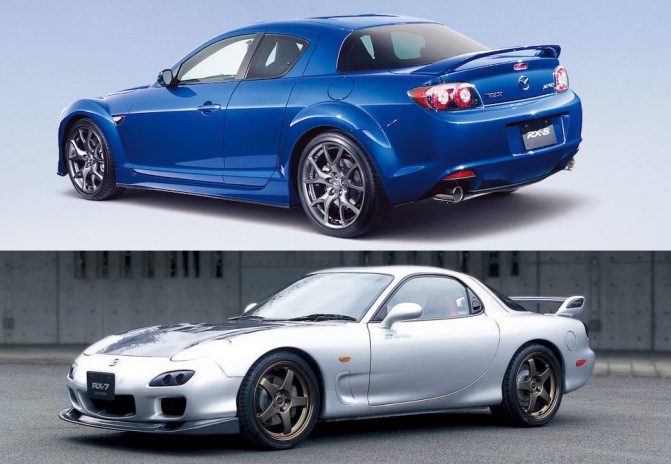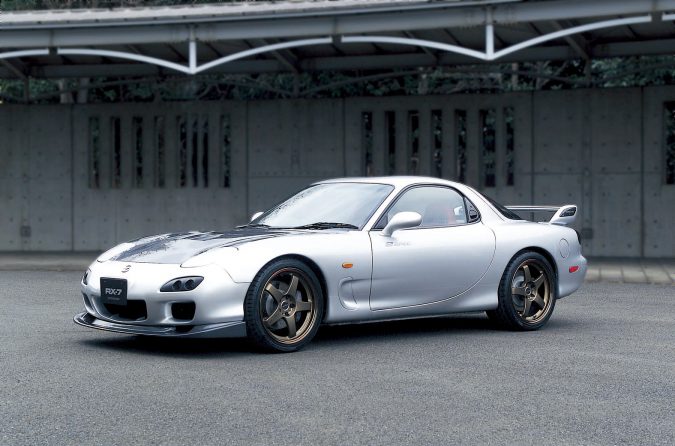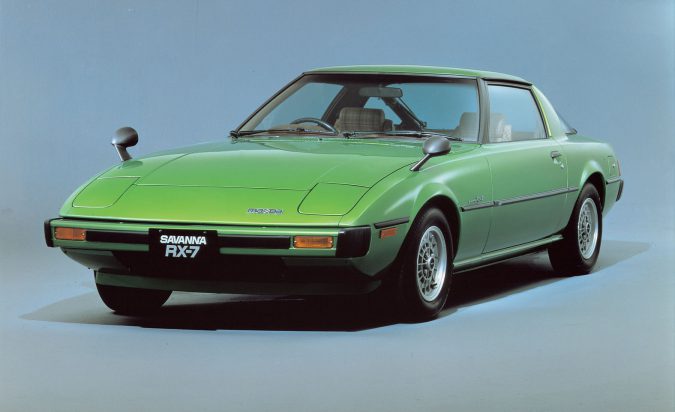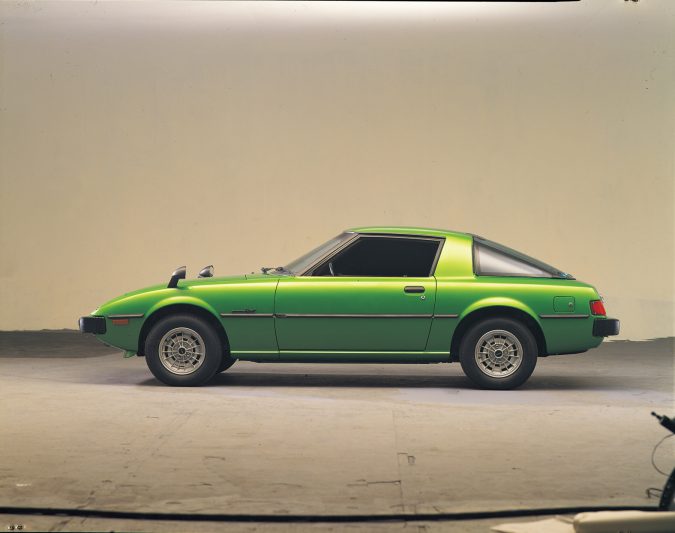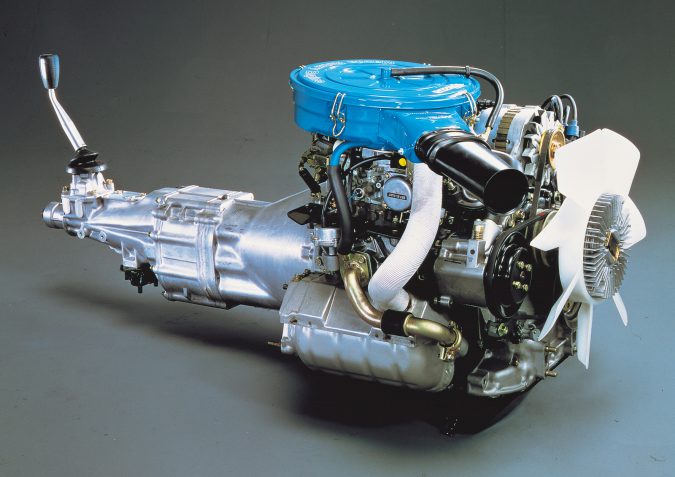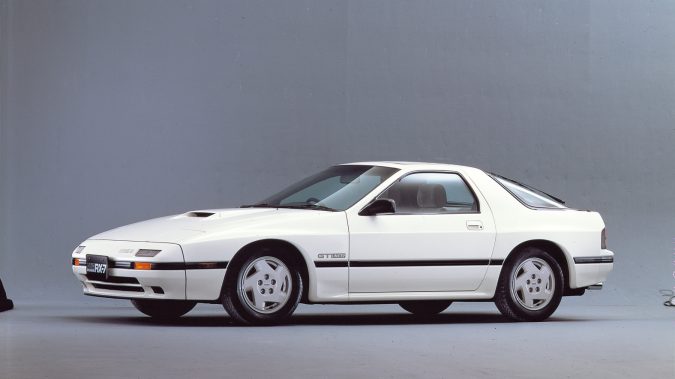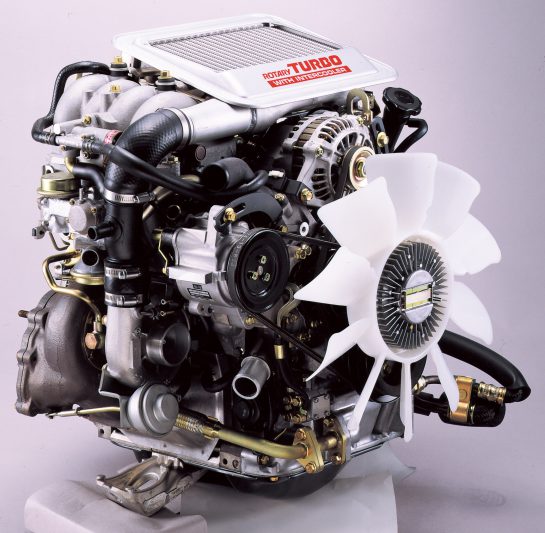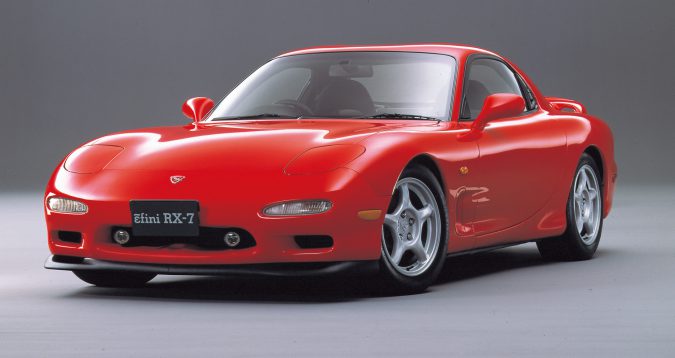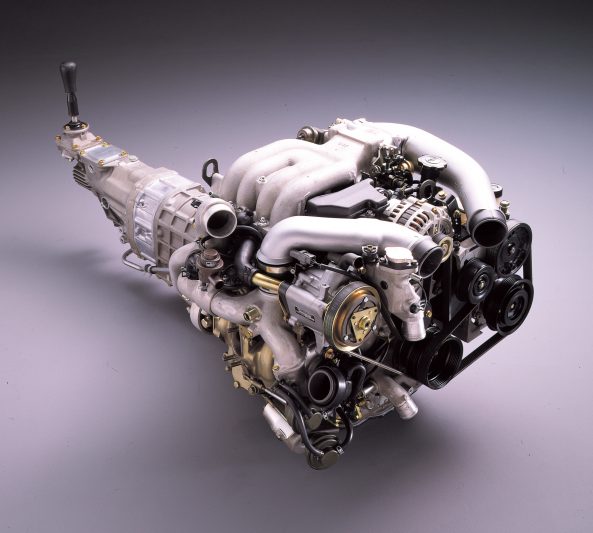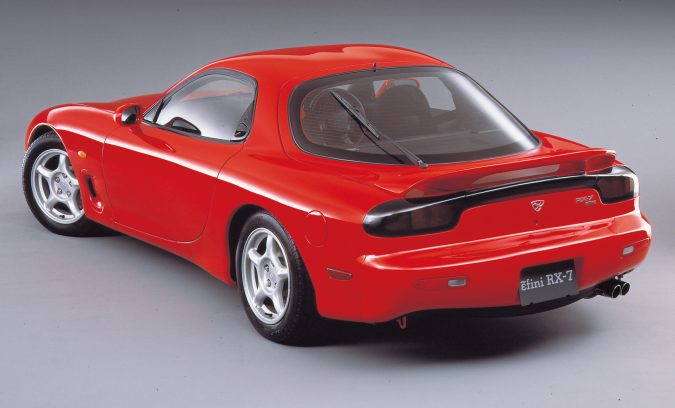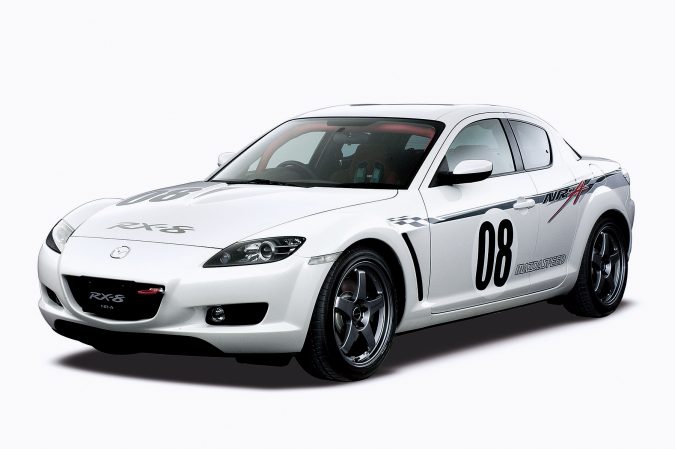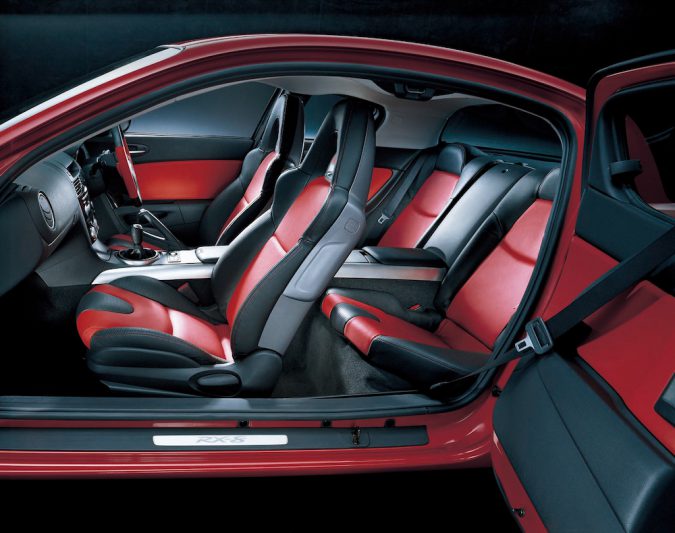Anyone who’s ever taken a gander at the classifieds for a JDM classic will be in awe of the price disparity between two Mazda coupes – the RX7 vs RX8. Both have fundamentally the same notion behind them, rotary-powered, front-mid engine rear-wheel-drive sports cars.
However, that is essentially where the similarities end. Over its lifetime, over 800,000 RX7s were produced, compared to the 200,000 RX8s. While the RX8 is designed and developed to appeal to a broad audience, the RX7 was Mazda’s halo sports car.
RX8 Vs RX7
In fact, the RX7 is such a legendary car that it is now synonymous with the image of a rotary engine. The rapid pulsations of a rotary engine correlate directly to the sleek third-generation RX7. It’s so iconic that even for a non-petrolhead, the shape of an RX7 is immediately recognizable.
On the other hand, we have the RX8. It’s a common misconception, but the RX8 was never intended as a direct successor to the RX7. Keep in mind that if Mazda ever builds a successor to the RX7, it will still be named the RX7. This is how Mazda nomenclature has always worked.
The RX8 is a standalone car meant to be judged by itself. If Mazda wanted to push the rotary engine forward, they knew that they needed a mainstream car that would intrigue the public, not just the enthusiasts. Hence, the RX8 was developed to do a bit of everything, and I’d say it’s done a good job at that.
Both cars are born under very different times with a vast disparity in motive. Neither really has a direct competitor, but they do have a polarising charm to them. If you want an RX7 or RX8, there’s really no comparable alternative. And I reckon that’s the advantage Mazda possesses, allowing them to maintain an ardent fanbase for their classic sports cars.
Mazda RX7
FB RX7
Spanning over 3 generations, the Mazda RX7 was produced from 1978 to 2003. A significant lifespan for a unique Japanese sports car. The original first-generation RX7 (SA22C or FB3S) was a successor to the Savanna and is thus colloquially referred to as the RX7 Savanna.
Interestingly, the whole idea of the RX lineup of cars wasn’t to be a defining sportscar. It’s to take advantage of the rotary’s efficacious output to displacement ratio. And because the rotary engine is so compact, it can keep the size of the FB3S small. Both are methods to circumvent Japanese regulations and taxes.
This meant that while the FB3S was affordable for buyers to keep on the road, it puts out more power than its inline-engine peers. While the handling was agile for its time, the FB3S’s powerplant takes the most notice. A carburetted 1.1-litre naturally-aspirated rotary engine dubbed the 12A.
By then, the 12A was already used in multiple Mazda models. In the FB3S RX7, it produced ~100 horsepower and roughly 130 Nm of torque. Not much, but the FB3S only weighed a tonne, so it was adequate for the time. More notably, nothing back that’s as well-priced touted an engine that could rev effortlessly to a 9,000 RPM redline.
At the end of the FB3S’s life, the 12A was being phased out. Some were being powered by the fuel-injected 13B-EGI. But most notably, a limited amount was powered by the turbocharged 12A with its 160 horsepower. This indicated the direction the RX7 was heading towards.
FC RX7
By 1986, the second-generation RX7 was finally introduced. Known as the FC3S, Mazda went on a horsepower race with multiple iterations of its turbocharged 13B engines. The most powerful S5 Turbo models even got over 200 horsepower and 265 Nm of torque.
It’s not as ‘pure’ or visceral to drive as the FB3S was, but it’s still a successful model nevertheless. The FC3S also marked the change towards a fully independent rear suspension setup in lieu of the live rear axle utilized by the FB3S.
FD RX7
However, it was not until the early 90s when Mazda brought out the now esteemed 3rd-generation FD3S RX7 that the turbocharged 13B got further refined. Introduced alongside the FD3S is the equally revered 13B-REW.
The 13B-REW is one of the world’s first volume-production sequential turbocharged engines. While it brought along many complexities, it allowed Mazda to extract a mighty 250 horsepower and 294 Nm from the 13B.
Crucially, this is all managed in a powerplant compact enough to maintain the front-mid engine layout of the FD3S RX7. It’s especially noteworthy when you consider that it still weighs just 300 lbs. Featherweight compared to other engines of its time producing similar power.
By the end of its life, the 13B-REW is making 276 horsepower and 314 Nm of torque. That’s on par with the early RB26DETTs and 2JZ-GTEs (per gentlemen’s agreement). All in a dense engine that displaces a rated 1.3-liter.
Of course, the brilliantly engineered 13B-REW is just part of the FD3S’s story. The relative lack of complex drivetrain electronics bar the sequential turbochargers kept the weight of the FD3S down. Front-aft weight distribution is maintained at nigh 50-50.
Even today, the FD3S is considered to be one of the finest handling true sports cars of all time. It’s important to note that while the FD3S is impeccably balanced to drive, it’s not exactly poised. The sequential turbocharging system attempts to iron out the torque band, but there’s still a bump in torque delivery when the larger turbo spools.
The palpable torque delivery has a tendency to induce oversteer for those that are uninitiated. Regardless, drivers that adapt to the FD3S’s quirk will find the RX7 to be a rewarding and enthralling drive. It’s a thrill to nail the corner exit at peak torque.
Mazda RX8
It didn’t take Mazda long to realize the need for another rotary-powered sports car. In fact, as early as 1995 Mazda had already conceptualized the idea of the RX8. It introduced the RX-01 concept car at the 1995 Tokyo Motor Show alongside an early design of the 13B-MSP engine.
Unlike the RX7s which are developed during the Japanese bubble economy era, the RX8 is built to accommodate the rapidly declining economy. There was no longer a sizable market for high-end sports cars such as the FD3S. Thus, mimicking the MX-5, Mazda went back to the drawing board for a fun-to-drive, basic sports car.
Hence the RX8 was debuted in 2001 and produced from 2002 to 2012. A huge departure from the RX7, the RX8 is a four-door 2+2 coupe with a naturally-aspirated 13B-MSP rotary engine. Dubbed the RENESIS, it shares pretty much nothing with the 13B-REW it supposedly supersedes.
Mazda RX8 Engine
The biggest change in the powerplant is arguably the change from turbochargers to none at all (aftermarket turbo kits are available). It’s an effort to keep the RENESIS emissions friendly enough to be sold globally, and it did just that. Producing 232 horsepower and 216 Nm of torque.
It was critical that Mazda maintained a peerless driving experience even in a toned-back sports car. That’s the RX8’s whole selling point after all. The compact dimensions of the RENESIS allowed Mazda to preserve a front-mid rear-wheel-drive layout with a 50:50 weight distribution.
Even if the RENESIS is a letdown in rotary enthusiasts’ eyes, it’s just perfect for the RX8. Creating a dynamic chassis with a linear power band meant that the RX8 is both enjoyable and approachable to drive. It’s relatively affordable too, with 200,000 made in total so used RX8s are still abundant today. If you are interested in the RX8 there is a lot to learn. There was a wide array of different trim levels that came out of the years not to mention the icing on the cake the RX8 R3.
You will also notice that a lot happened in the aftermarket world to tune the car. There is a wide variety of RX8 body kits available and lots of people have completed crazy engine swaps that are worth a look. The best suiting engine swap is the LS engine swap, so make sure to look at our guide.
From here on forth, all references to the RX7 will be in regards to the 3rd generation FD3S, seeing that it’s arguably the most beloved model out of all the RX7s.
RX7 VS RX8: Powerplant
It’s plain to see that both Mazda RX sportscars are powered by vastly different engines. They may be both rotary engines, but they are fundamentally different. For one, the 13B-REW touts a laudably well-engineered sequential turbo system, while the RENESIS is just naturally aspirated.
Aside from the power differences, there are design decisions that make an engine swap between those two difficult as well. The big difference between them is the fact that the RENESIS migrated to a multi-side port design. Ditching the peripheral port and hence eliminating any overlap.
This is mainly a choice for emissions. While the 13B-REW is efficient at displacing its exhaust gases, combustion isn’t always complete. This means that unburnt hydrocarbons will be dumped straight into the exhaust system, which is obviously bad for the environment.
With the multi-side ports, more unburnt gases can be retained for burning in the next cycle. This ensures a cleaner burn for better emissions. To compensate for the smaller port size, more exhaust ports are used (hence the MSP denotation). It’s designed to also delay exhaust opening time to harness more expansion energy from the combustion process. This helps to improve engine efficiency too.
However, it’s a compromise when you’re trying to extract more performance from the engine. This is one reason the RENESIS isn’t exactly turbo friendly, as the siamese central exhaust and small ports pose a restriction when more flow is needed. The peripheral ports in the 13B-REW enabled Mazda’s responsive, high output approach. As a side effect, it’s also the exhaust overlap that provides it with the distinctive rotary pulsating tone.
RX8 Engine
The whole power argument between the two engines is moot in my opinion. It’s obvious that Mazda designed both engines to best optimize the application. Mazda made design choices to make the RENESIS work as a naturally-aspirated engine. It also took advantage of its diminutive size to mount it even lower and further in than the 13B-REW in the RX7.
To be fair, we have to look at both engines by themselves. The 13B-REW was developed when there was a significant horsepower race in Japan. Obviously, because of the gentlemen’s agreement, the 13B-REW made ‘280’ horses, but it might have made more. And in the aftermarket industry, it’s a coveted engine for its tunability.
On the other hand, the RENESIS obviously makes less power and torque than the 13B-REW. But it weighs even less than the 13B-REW. For Mazda, a car with the purpose of the RX8 just wouldn’t work with the 13B-REW, bar the emissions regulations. It’s going to be too expensive and difficult for most people to drive daily.
Regardless, Mazda’s effort to extract as much as 232 horsepower from a naturally-aspirated 1.3-liter is worth plaudits. The RENESIS provides a smoother torque delivery for a forgiving cornering demeanor. It’s supposedly more fuel-efficient relative to other rotary engines.
With that said, there is little room for keen modders to extract even more power out of the RENESIS. It’s an engine that works best when kept in its stock condition and properly maintained. Without major modifications that fundamentally change the RENESIS, it’s difficult to make big power.
This is in contrast to the 13B-REW, which responds fondly to modifications. In fact, most people will just recommend you go for the 13B-REW if you’re looking for more than four to five hundred horsepower from the RENESIS.
RX7 Engine
The 13B-REW has immense potential to yield plenty of power. In fact, if you check out the Australian modification scene, you’ll find that there are many who have pushed the 13B-REW far above and beyond its dimensions.
It’s also worth noting there’s more than just the 13B-REW. In fact, because the FD3S isn’t too common the 13B-REW can be tricky to source. The Mazda Cosmo also received an even rarer 13B-RE optimized for a grand tourer. For most people, the late-variant 13B-Ts are a good alternative, although not quite comparable to the 13B-REWs.
Aside from the completely different exhaust port design, the RENESIS also has lightened rotors and an increased compression ratio. The apex seals are also thinner and smaller to reduce friction. It also features a rather complicated intake system that staggers air intake into the ports to improve engine response.
The 13B-REW, on the other hand, has two sequentially charged Hitachi HT-12 turbochargers. One larger than the other. The primary is the smaller one which provides the initial poke while the secondary turbo carries through the upper end once the engine goes past 4,500 rpm.
The disadvantage with the REW’s system is, that as much as Mazda tried to, it didn’t exactly provide a smooth powerband. There was always an odd jump in torque that drivers had to account for. And the complex turbochargers turned the engine bay into a labyrinth of hoses and solenoids.
Intriguingly, while the RENESIS isn’t exactly favored as an engine swap candidate, the transmission is commonly used for other applications. Both the RX8 and FD3S run the same powerplant frame design in lieu of a transmission mount.
RX7 Vs RX8: Transmission
The 5-speed model (the low-power, S1 4-port version) RX8 actually has a transmission very similar to that found in the RX7 5-speed. Bar the unique pull-type pressure plate used in the RX7 and different shifter locations. Some people purchase the RX7 5-speed, which is more robust, and sacrifice the RX8 5-speed to fit the RX7’s transmission into the RX8.
Before you think that the RX8’s 6-speed is a better transmission than the RX7, take note that the extra gear is needed to keep the RENESIS in power. The 6th gear in the RX8 is shorter than the 5th gear in the RX7 (0.83 to 0.80). The 6-speed actually acts more like an extra gear between the 2nd and 3rd in the RX7. Otherwise, it’s a weaker transmission that closely relates to the MX-5 6-speed.
RX7 VS RX8: Chassis
The short answer for most people would be to stick with the RX7 for a bona fide sports car driving experience. Even today, the FD3S is regarded as offering a world-class handling experience. Hence, many Japanese tuning companies still run the FD3S as their car of choice. If possible, the later Type R models will provide you with the visceral RX7 experience.
In fact, by the end of its production, Mazda quickly realized that the RX7 has evolved into a high-end, no-compromise sportscar. It has shifted into a niche market, and that’s the whole reason the RX8 took such a big departure from the FD3S.
However, if you want an experience of a true sports car with surprising practicality, then the RX8 is the car of your choice. It has modern safety amenities, four doors, a 2+2 arrangement, a decent boot, and acceptable fuel efficiency. And the RX8 holds itself very well in the corners too, should you find yourself a bit overzealous.
Intriguingly, if you just look at the suspension diagrams for both cars, they may look quite similar. In fact, the RX8 has made improvements over the FD3S RX7. These mainly do away with the excessive amount of bushings used in the RX7 and make the car easier to drive at the limit.
In the RX7, both the front and rear suspension use a double-wishbone design. This type of setup is typically reserved for high-end sports cars. All wheels use a ventilated rotor brake, with the front opting for 4-piston while the rear only needs a single-piston brake caliper. Anti-lock brake is a standard feature in the FD3S.
Double Wishbone Vs Multi-Link
On the other hand, the RX8 resorts to a front double wishbone, and rear multi-link setup which is more conventional. However, Mazda has resorted to single-piston brakes front and back. It’s not necessarily a downgrade though, as the RX8’s stock braking system is regarded as excellent. It’ll certainly be more than adequate for street use.
The RX8 also ditched the strange sliding bushings and thus pillow ball bushings used in the FD3S. These are intended to reduce rubber deflection under load and allowed Mazda to better tune the bushings for lateral rigidity.
It’s a method that actively influences the toe of the car while driving. Therefore, to reduce costs, Mazda removed these. According to Mazda, it also gives a purer, more natural feel to the RX8’s handling characteristics.
The big improvement found in the RX8 is its dedication to ride quality and balance. To keep everything as centralized as possible, Mazda used every trick in the book. For example, the RENESIS sits 40mm lower and 60mm further back than the 13B-REW in the RX7. The fuel tank is also relocated beneath the rear seats.
This means that while the RENESIS weighs quite a bit more than the FD3S, more of it is closer to the center. It contributes to the agility of the RX8 and means that it feels nimbler than it looks. Less weight from the nose translates to more responsive steering.
Of course, all of the suspension changes are responsible for the disparity in how both cars feel. The biggest change, however, remains in the engine bay. By removing the turbochargers Mazda has greatly improved the quality of torque delivery. A linearised powerband makes the RX8 much more predictable around corners.
RX7 Vs RX8: Handling
However, to drive the RX8 well, you have to drive it at the limit. There’s not much torque reserve for the RX8. Once you enter a corner, you must commit. That’s the appeal of the FD3S. Its addictive torque delivery allows you to trim your cornering path, and it’s more forgiving at low revs.
The truth is that while many people look to the RX7 as one of the finest handling cars in the world, not many are bestowed the talent to drive it at the absolute limit. It’s not an easy car to drive well. The truth is that the 13B-REW is too heavy. All that nose weight meant that the FD3S lost the spirit of the featherweight FB3S.
An easier car to drive means that it’s a quicker car for most people. That’s what makes the RX8 an endearing sports car for many. It’s a lot closer to what the MX-5 offers, but with the feel and spirit of a rotary engine. Both cars are great handling-wise, but provide a very different approach and experience.
RX7 VS RX8: Verdict
Regardless of what you might think, the RX7 is a marvel. It provided people with a different option and even pushed rotary engines to the mainstream. Even today, there are dozens of ardent fans tinkering and tweaking their rotary engine. It has a character that piston engines lack.
The 13B-REW put into the RX7 FD3S is one of the finest rotary engines yet. Combine that with a chassis that rivals the Porsche 911 of its day with looks that can only be regarded as timeless, it’s not hard to fathom why the RX7 has become a legend. Prices for quality examples are already on the rise.
On the other hand, it’s likely that the RX8 will never be quite so fondly remembered. Its unfortunate reputation marred by tales of woes scares most prospective owners away. Regardless, I think that the RX8 is undeservingly referred to as a mechanical nightmare, with endless flooding issues.
That said, precisely because of its bad reputation, used RX8s are typically found for cheap. Certainly, prior to a purchase decision, do your research. It applies doubly so for rotary-powered vehicles, as the upkeep is a lot more than its entry price indicates.
Mazda RX8 vs RX7: Key Facts to Know
- Mazda RX8 is a newer model that emerged in 2000, while the RX7 appeared in the 1980s.
- RX8 has a top speed of 230-240 kmph, while RX7 reaches up to 190-200 kmph.
- Mazda RX8 weighs approximately 1370 kg, while RX7 weighs around 1100 kg.
- RX8 comes in 5 & 6-speed manual and 4 & 6-speed automatic transmission models, while RX7 is available in 4 & 5-speed manual and 3 & 4-speed automatic transmissions.
- Both Mazda RX8 and RX7 cars run on all types of gasoline and are 1300 cc in engine power.
- The RX7 was available in 1.1 L to 1.3 L engine capacities.
- The weight of an automobile plays an imperative role in its performance.
- Speed and acceleration are crucial factors to consider when buying a sports or sedan car.
- Both Mazda RX8 and RX7 offer a complete package of power, comfort, luxury, looks, and security.
- Buyers should keep the differences and similarities in mind while investing in Mazda cars.
FAQs On RX7 Vs RX8
If you’re still curious about RX7 vs RX8 and which one’s the right fit for you, perhaps our FAQs here might help…
How Much Is A Mazda RX7
Although the RX7’s been out of production for 20 years now (as of 2022), it remains a highly sought-after car. Its iconic 13B rotary engine, superb handling, as well as some pop culture love thanks to Initial D (among others), have made the RX7 a legend among car enthusiasts. It’s also one of the last and few cars that you can buy with a rotary engine – and a great one, at that! This also means that RX7s, especially the 3rd-generation FD, are valued pretty highly. If you want to buy one today, a special RX7 with a lot of provenance could cost you as much as $150,000. Meanwhile, more ordinary RX7s with low mileage and in mint condition will set you back between $50,000 to $70,000. Although, most RX7s will likely average between $20,000 to $40,000, depending on the spec and condition.
Are Rotary Engines Reliable
When discussing rotaries, a highly divisive topic will concern their reliability. There have been a lot of horror stories mentioned around the rotaries breaking down too often. To clear up a misconception, rotary engines are actually pretty reliable. They have fewer moving parts and technically operate more potently than conventional piston engines. However, rotary engines can be unreliable if you don’t take good care of them, and it does require very frequent maintenance. More so than typical piston-based engines. Rotaries burn a lot of oil owing to how it’s been engineered. Additionally, they run hotter and at higher stress levels, which wears out secondary components much faster. As such, good and diligent maintenance is necessary to keep a rotary engine running reliably.
What Cars Have Rotary Engines
The first production car to feature a rotary was the NSU Wankel, named after the man who conceptualized Wankel rotary engines. In more recent times, the only automaker to have used rotary engines en masse is Mazda. Besides NSU, they were also an early adopter of rotary engine designs – by virtue of Mazda wanting to stand out. Since the 60s, Mazda’s top-end performance cars were typically powered by rotary engines. In particular, the Cosmo, RX-7, and RX-8. The latter of which was the last production car to come with a rotary engine, and was discontinued in 2012. Rumor has it that Mazda plans on bringing back the rotary in a future flagship sports car.
Are Mazda RX8 Reliable
There’s a misconception that the Mazda RX8 is an unreliable car. Technically speaking, the RX8 is actually a pretty reliable car, with generally minimal faults and issues when compared to its competitors. Although, the RX8 can be very unreliable if not cared for properly. Most of this revolves around its RENESIS rotary engine, which requires a lot of maintenance and servicing. It burns through plenty of oil, runs hotter than you’d like, and wears out its internals rather quickly. This means you’ll have to change the oil, as well as replace spark plugs, ignition coils, and even the catalytic converter more frequently than most other cars.
What Does FD Mean In Cars
When using the term FD, it relates to either a Honda Civic or a Mazda RX-7. Both of which use FD as either a generational name or a chassis code. Depending on whether you’re a Honda or Mazda enthusiast, the term FD might excite you differently. In Mazda’s case, the RX-7 FD remains to be one of its most iconic sports cars. This is mainly due to its 13B engine, which uses a complex and ground-breaking sequential turbocharging setup. It’s a highly potent engine and it’s a featherweight compared to most other powertrains. As such, and due to the low mass and excellent weight distribution, the FD RX-7 also handles brilliantly.

